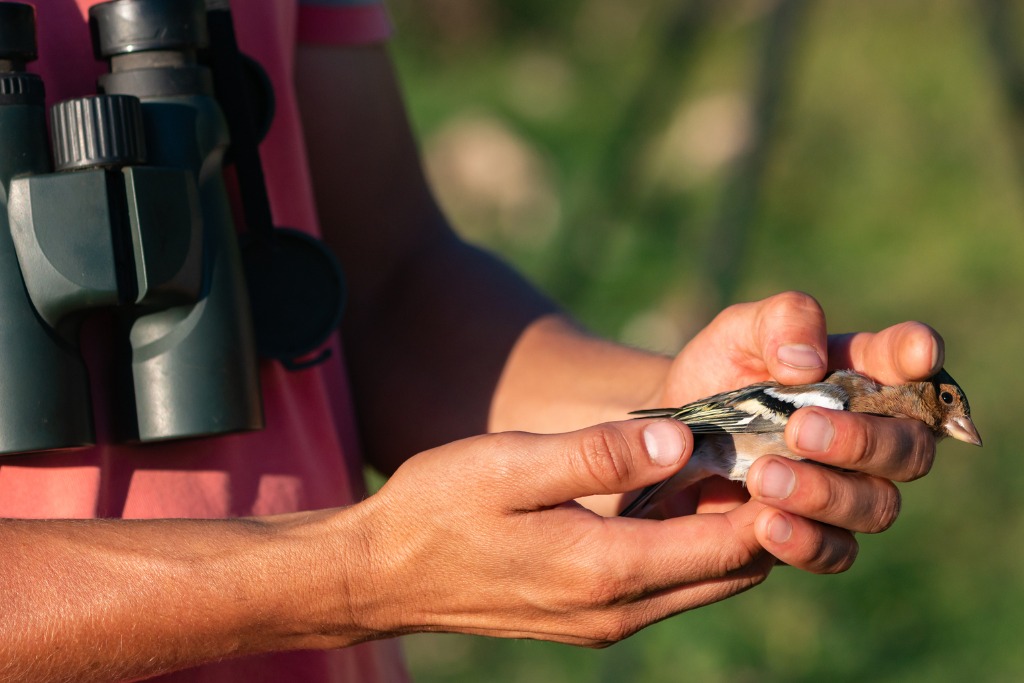
Person wearing binoculars holding a bird
Birding Buddies
Grade 1
This lesson focuses on two main ideas:
- How ornithologists use estimation methods to understand bird populations
- The essential skills that an ornithologist needs to have to study bird species and effectively conserve their habitats
Procedure
INTRODUCTION (15 minutes)
Ask students the essential question, “How do people know when a population of animals is going up or going down?” Tell students that people cannot go out and count all the animals. They observe and count what they can see. Based on this, they can use math to get a good idea of how many animals there are. One example of this comes from the work that ornithologists do. Ornithologists are people who study birds.
Have students watch “Outdoors Maryland - Episode 3501” video. After the video, have a discussion around the essential questions and thinking questions aligned to the topic and video.
EXTENSION (15-30 minutes)
Model the work that ornithologists do by using multi-colored beans, rocks, or small pieces of paper. Ask students to predict how many pieces there are of each color. Have students take a handful. Create a pictograph of each color. Replace the pieces, stir, or shake the container and conduct the process two more times. Ask students to compare the graphs. Tell them that this is a very similar process to what ornithologists do. They use the data to make an estimate or good guess about how many birds live in the area.
ASSESSMENT (15 minutes)
Ask students to describe how ornithologists estimate the number of birds living in an area.
REFLECTION (10 minutes)
Ask students to think about what an ornithologist needs to know in order to be good at estimating the number of birds living in an area.
Standards
1-LS3-1 Heredity: Inheritance and Variation of Traits
Make observations to construct an evidence-based account that young plants and animals are like, but not exactly like, their parents
- Constructing Explanations and Designing Solutions
Constructing explanations and designing solutions in K–2 builds on prior experiences and progresses to the use of evidence and ideas in constructing evidence-based accounts of natural phenomena and designing solutions.- Make observations (firsthand or from media) to construct an evidence-based account for natural phenomena.
- Disciplinary Core Ideas
LS3.A: Inheritance of Traits
- Young animals are very much, but not exactly like, their parents. Plants also are very much, but not exactly, like their parents.
- Individuals of the same kind of plant or animal are recognizable as similar but can also vary in many ways.
- Crosscutting Concepts
Patterns
- Patterns in the natural and human designed world can be observed, used to describe phenomena, and used as evidence.
Understanding about the Nature of Science
Science is a Human Endeavor: Men and women of diverse backgrounds are scientists and engineers.
Standard 5
Individual and Collective Responses to Environmental Change:
PreK-2 Objective A. Generate examples of individuals or groups that protect the environment.
Summative CER
Option 1:
Construct an explanation of how ornithologists estimate bird populations. Use evidence from the video and activities to support your explanation.
Option 2:
After observing an ornithologist at work, a student claims that we know exactly how many birds there are in the world. Is the student correct? Use evidence from the video and activities to support your response.
Reflection Questions
- Who can be an ornithologist?
- What skills does an ornithologist need to have?
Summative CER Rubric
| Scoring Rubric Components | No Response Score Point 0 |
Not There Yet Score Point 0.5 |
Beginning To Score Point 0.75 |
Yes Score Point 1.0 |
|---|---|---|---|---|
| CLAIM | The claim is missing. | The claim is incorrect or irrelevant. | The claim partially takes a position on the topic or issue addressed within the prompt. | The claim takes an appropriate position on the topic or issue addressed within the prompt. |
| EVIDENCE | There is no type of evidence in the response. | The evidence is irrelevant or does not support the claim. | The evidence partially supports the claim and demonstrates some understanding of the topic or text, using appropriate sources. | The evidence supports the claim and demonstrates a strong understanding of the topic or text, using appropriate sources. |
| REASONING | There is no use of words, phrases, and/or clauses to create cohesion and to clarify the relationship between the claim and evidence. | The use of words, phrases, and/or clauses fails to show or explain any relationship between the claim and evidence. | Scientific words, phrases, and clauses used lack cohesion but partially clarify the relationship between the claim and evidence. | Appropriate scientific words, phrases, and clauses are used to create cohesion and to clarify the relationship between the claim and evidence. |